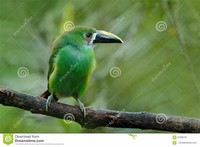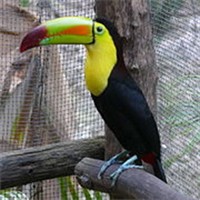Facts about Toucan

Toucans are primarily frugivorous (fruit eating), but are opportunistically omnivorous and will take prey such as insects and small lizards (Ramsen et al.

When the eggs hatch, the young toucans emerge completely naked, without any down.

The feathers in the genus containing the largest toucans are generally black, with touches of white, yellow, and scarlet.

Toucans are found in Central America, South America, the Caribbean, and southern Mexico.

The toucan bill has very limited use as an excavation tool and thus they are dependent on existing treeholes.

Reflecting the principle of bi-level functionality, toucans provide a larger function for the ecosystem and for humans while advancing their own individual functions of survival and reproduction.

The underparts of the araзaris (smaller toucans) are yellow, crossed by one or more black or red bands.

A toucan's tongue is long (up to 14 to 15 centimeters, or 6 inches), narrow, gray, and singularly frayed on each side, adding to its sensitivity as an organ of taste.

A structural complex probably unique to toucans involves the modification of several tail vertebrae.

On the one hand, the toucan is of indirect benefit to the macaw's reproduction but being the main seed dispersal of the the manduvi tree, where the macaw often nests.

Toucans are largely fruit-eating, and as such disperse the seeds of various plants, while being consumed at various stages by such predators as eagles, big cats such as the jaguar, coatis, and snakes.

The colorful, giant bill of toucans, which in some large species measure more than half the length of the body, is the hallmark of the family.

Toucans, family Ramphastidae, are members of the order Piciformes, a taxon of six families of largely arboreal birds, the best-known of them being the Picidae, which includes the woodpeckers and close relatives.

The complexity of biological interactions is seen in the direct and indirect relationship of the large toco toucan (Ramphastos toco) and the hyacinth macaw (Anodorhynchus hyacinthinus).

Toucans are closely related to the American barbets of the Capitonidae family and belong to the same order as the woodpeckers.

The majority of toucans do not show any sexual dimorphism in their coloration, the genus Selenidera being the most notable exception to this rule (hence their common name, "dichromatic toucanets").

Captive toucans have been reported to actively hunt insects in their cages, and it is possible to keep toucans on an insect-only diet.

The bill has forward-facing serrations resembling teeth, which historically led naturalists to believe that toucans captured fish and were primarily carnivorous, but today it is known that they eat mostly fruit.





